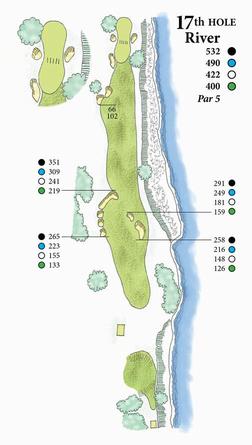Hole Overview  Architects Notes by Gil Hanse Architects Notes by Gil Hanse
Having back to back par 5 holes for a finish is one of the unusual features of the Waverley course. As a result, it was our hope to create two distinctly different and entertaining golf holes. The 17th is all about the tee shot unlocking the key to the hole from its dramatic perch above the river (and from the back tees its unconventional drive over the rear of the 16th green), the golfer is faced with a dramatic array of bunkers. Finding the right line and a safe landing on grass will be the challenge. If the challenge is met, most golfers can either get close enough for a short approach or reach the green in two. If a sandy repose is found then work must be done to reach this wonderfully quirky green in regulation. History The origin of the historical name “River” was due to the original fairway location running treacherously along the bank of the Willamette River.
1952 USGA Women’s Amateur Championship… Pung and McFedters stepped up to the 510 yard 17th. McFedters drove well enough, but Pung out drove her opponent by at least 50 yards. McFedters second was 100 yards short of the green. Pung took a wood and hit a perfect stroke, the ball flying straight for the green and finishing 15 feet short of the cup. She left her eagle putt 14 inches short of the pin and dropped her second putt for a birdie four. She won the hole with that four and the USGA Women’s Amateur Championship final two and one on Waverley’s 17th green. The 1952 USGA Women’s Amateur was Portland’s first ever Women’s Amateur Championship. 1970 USGA Men’s Amateur Championship… Next came the 448-yard 17th hole that had been giving the entire field nightmares all week long. It proved consistent by chewing up both Wadkins and Kite for a pair of double bogeys. Wadkins after a second shot into a bunker and Kite after a second shot into the neighboring Willamette River. “The ball squirted to the left on me and I couldn’t have had a worse lie in the trap,” Wadkins remembered later. 1993 USGA Junior Amateur Championship… Tiger Woods, during his 1993 march for three consecutive Junior Amateurs, chose Driver, and stuffed a 9-iron to the second level and eight feet from the pin at the 432-yard 17th, easily that week’s toughest hole. “I knew he wasn’t going to birdie the 17th, because it is almost impossible to birdie,” Tiger said about Armour later that day. Ryan Armour hit a 3-wood off the tee, a 4-iron to the right of the green and chipped within three feet. As he lined up his birdie putt that, had he missed, would have finished him, Woods muttered to his caddy, Jay Brunza, “Got to be like Nicklaus. Got to will this in the hole.” Tiger made his putt for birdie to pull within one rendering Armour’s 18-inch par putt meaningless. Impossible? Improbable perhaps. But for Woods, who has made a career out of cliffhanger finals, a birdie-birdie finish would leave the gallery of 2,000 plus rubbing their eyes in disbelief. “I don’t know how far that putt was. I don’t know where I played it, I don’t know how I did it.” Woods said. “I just hit it and it went in.” Armour had let his mind wander. “If I parred 17 I thought I would win the match,” Armour later said. He had prematurely imagined his name engraved on the championship trophy.
|